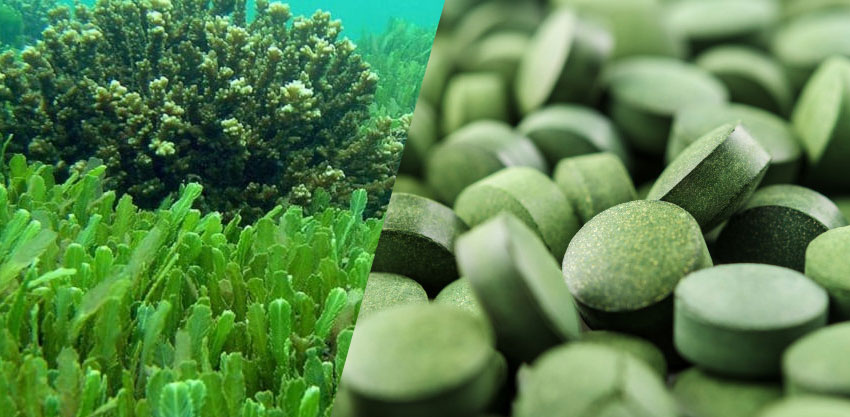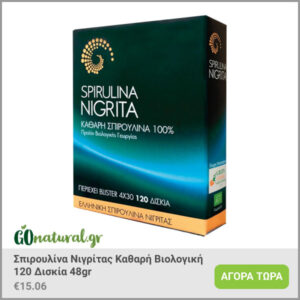Spirulina: 10 Benefits it offers to our Organization
| On Dec03,2021
Spirulina is an extremely important superfood and one of the most popular
dietary supplements due to the significant benefits it offers to
our organism.
Food rich in various nutrients and antioxidants, spirulina
enhances the health of both the brain and the body in general.
Let’s look at 10 important benefits of spirulina for the body!
 1. Spirulina is extremely rich in many nutrients
1. Spirulina is extremely rich in many nutrients
Spirulina is an organism that grows in both sweet and savory
water. It is a type of cyanobacteria, ie a family of monocytes
germs often referred to as blue-green algae.
Like plants, cyanobacteria produce energy from sunlight through it
photosynthesis. The ancient Aztecs used spirulina, but it happened again
popular when NASA proposed the cultivation of this type of cyanobacterium in
space for use by astronauts ( 1 ).
A typical daily dose of spirulina is 1-3 grams, but doses up to 10
grams per day are used effectively. This little seaweed is
rich in nutrients, as one tbsp. (7 grams) of dried powder
spirulina contains ( 2 ):
• Protein: 4 grams
• Vitamin B1 (thiamine): 11% of S.H.P.
• Vitamin B2 (riboflavin): 15% of S.P.
• Vitamin B3 (niacin): 4% of S.I.P.
• Copper: 21% of S.H.P.
• Iron: 11% of S.H.P.
• It also contains significant amounts of magnesium, potassium and manganese and small
amounts of almost every other nutrient the body needs.
In addition, the same amount contains only 20 calories and 1.7 grams of digestible
carbohydrates and possibly therefore the most nutritious of all
planet. A c.s. (7 grams) spirulina contains a small amount of fat –
about 1 gram – including omega-6 and omega-3 fats
acids in a ratio of about 1.5-1.0.
The quality of spirulina protein is considered excellent – comparable to
egg protein and provides all the essential amino acids that o
organization.
There is speculation that spirulina contains vitamin B12, but this is false. The
seaweed it contains pseudovitamin B12, which has not been proven to be
effective for humans ( 3 , 4 ).
2. Strong antioxidant and anti-inflammatory properties
Oxidative damage can damage the body’s DNA and cells. THE
This condition may cause chronic inflammation, which contributes to
development of cancer and other diseases ( 5 ). Spirulina is an excellent source
antioxidants, which protect against oxidative damage.
Its main active ingredient is called phycocyanin. This antioxidant
gives spirulina its unique blue-green color. Phycocyanin
possibly fighting free radicals, inhibiting production
inflammatory signaling molecules, providing impressive antioxidants and
anti-inflammatory effects ( 6 , 7 , 8 ).
3. Reduces levels of “bad” LDL and triglycerides.
Heart disease is the leading cause of death and many factors
associated with an increase in heart disease. Such as
It turns out that spirulina acts positively against these factors. For
For example, it lowers total cholesterol, “bad” LDL cholesterol and
triglycerides, while increasing the “good” HDL cholesterol.
According to a study in 25 people with type 2 diabetes, 2 grams of spirulina per
significantly improved cholesterol levels ( 9 ). According
other clinical trials in individuals with high cholesterol, 1 gram of spirulina per
day reduced triglycerides by 16.3% and “bad” LDL by 10.1% ( 10 ).
At the same time, several further studies have recorded significant favors
results – although with higher doses, e.g. 4.5 – 8 grams on ( 11 , 12 ).
4. Protects “bad” LDL cholesterol from oxidation.
Our body’s fat structures are sensitive to oxidative damage,
a condition known as lipid peroxidation, a key factor in many
serious diseases ( 13 , 14 ). For example, one of
the main causes for the development of heart disease is the oxidation of “bad”
LDL cholesterol ( 15 ). It is extremely interesting that the
Spirulina antioxidants appear to be particularly effective in reducing
of lipid peroxidation in humans and animals ( 16 , 17 ).
According to clinical studies in 37 people with type 2 diabetes, 8 grams
spirulina per day significantly reduced oxidative damage indices, while
also increases the levels of antioxidant enzymes in the blood ( 18 ).
5. May have anti-cancer properties
Some evidence suggests that spirulina has anti-cancer properties.
According to animal studies, spirulina may reduce it
carcinogenesis and tumor size ( 19 , 20 ).
The effect of spirulina on oral cancer has been investigated.
According to studies in 87 people from India with precancerous lesions –
Oral fibrosis (OSMF), 45% of patients saw normalization
of alterations. ( 21 ). About 50% of these patients
relapsed within one year of discontinuation
spirulina.
According to other studies in patients with OSMF lesions, 1 gram of spirulina per
day significantly improved OSMF symptoms compared to the drug
Pentoxyfilline ( 22 ).
6. Fights hypertension.
Hypertension is a major cause of many serious illnesses, such as heart attack,
stroke and chronic kidney disease. 1 gram of spirulina may work
effectively, however a dosage of 4.5 grams per day has been shown to
lowers blood pressure in people with normal levels. ( 10 , 11 ).
This decrease is believed to be due to increased production of nitrous oxide,
a signaling molecule that helps relax and dilate blood vessels
vessels ( 23 ).
7. Improves the symptoms of allergic rhinitis
Allergic rhinitis is due to inflammation of the nasal passages and is caused by
environmental allergens, such as pollen, animal hair, etc. Spirulina is one
popular alternative treatment for allergic rhinitis symptoms and according to
the indications so far can be effective ( 24 ). According
with a study in 127 people with allergic rhinitis, 2 grams of spirulina per day
reduced dramatic symptoms such as nasal discharge, sneezing, nasal congestion
and itching ( 25 ).
8. Acts effectively against anemia
There are different forms of anemia. The most common is characterized by
decrease in hemoglobin or red blood cells. Anemia is quite common
in the elderly and causes a prolonged feeling of weakness and fatigue
( 26 ).
According to a study in 40 elderly people with a history of anemia, the supplement
spirulina increased the content of red blood cells in hemoglobin
and improved immune function ( 27 ). However, it must
be taken into account that this is a study and further investigation is necessary.
9. Improves muscle strength and endurance.
The oxidative damage caused by exercise contributes significantly to
muscle fatigue. Some plant foods have antioxidant properties that
can help athletes and physically active people to
minimize this damage. Spirulina seems to have a beneficial effect on
strengthening and improving muscle strength and endurance. According to two studies, the
spirulina increased endurance, prolonging the period until fatigue
( 28 , 29 ).
10. Controls blood sugar levels.
According to animal studies, spirulina is associated with a reduction in
sugar levels. In some cases it is more effective than other drugs
for diabetes, including metformin ( 30 , 31 , 32 ). There is also evidence that spirulina may be effective in humans.
According to a study in people with type 2 diabetes, 2 grams of spirulina per day
led to a dramatic reduction in blood sugar levels ( 9 ) and a reduction in the HbA1c index – long-term glucose levels – from 9% to
8%, a very important fact. According to studies, a reduction of this index by 1%
can fight 21% of diabetes-related death risk
( 33 ). However, in any case further investigation is
necessary.
Summarizing…
Spirulina is a type of cyanobacteria – often referred to as turquoise
algae – and is an extremely healthy nutrient. Spirulina can improve
lipid levels, fight oxidation, lower blood pressure
and sugar levels.
Although further studies on the beneficial effects of spirulina are
necessary, this blue-green algae may be one of the few
nutrients that deserve the title of “superfood”.


